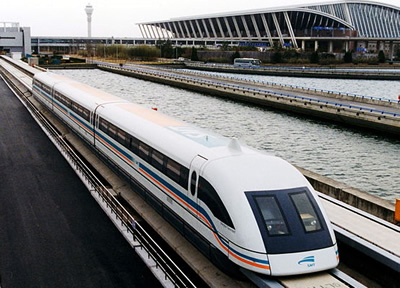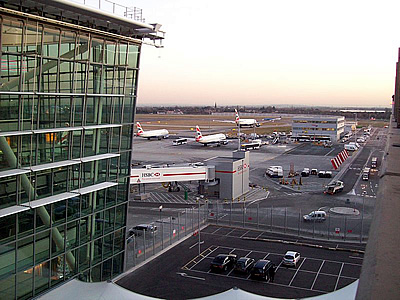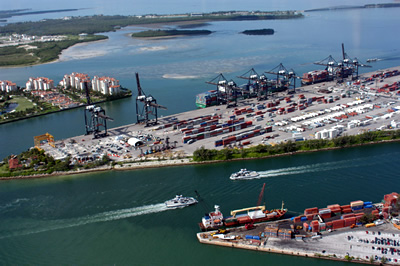The movement of goods and people has always been essential to our economic, social and political development. To enable this movement to take place modern societies have created various kinds of transport systems, such as canals, railways, roads, pipelines, airports and seaports.
The form of any system and its relationship with the physical landscape in which it is built result from the interaction - and interdependence - of many factors. They include the system's function - particularly the characteristics of the traffic it has to carry - the technological knowledge at the time it is built, and the level of finance and organization available.
Inland Waterways
Rivers can be modified for commercial navigation by dredging and straightening, or a canal can be dug to bypass part of a river's course. On the River Rhone, for example, canal bypasses not only improve navigation along the river but are also the sites of hydroelectric power stations.
For a canal to cross a major watershed between rivers, it must be made to ascend and descend, and water must be supplied to the summit level. The usual method of negotiating gradients is by locks, such as those in the Panama Canal or in the Soo canals between Lakes Superior and Huron. Alternatively a vertical lift can be used, which has the advantage of saving the water consumed by a boat's passage through locks.
Cheaper surface crossings (but at the expense of more locks) can be made at higher levels; in this case water may have to be pumped up to the summit. Canals are efficient as a means of moving freight; the Panama Canal for example, a vital link between the Atlantic and Pacific seaboards of the Americas, can take 80,000-ton ocean-going vessels.
On the Great Lakes, ore and grain from ports such as Chicago are carried via the Saint Lawrence Seaway by canals which have become an international trade route to the Atlantic Ocean.
Rail and Road Transport
Pioneering railway engineers in early nineteenth-century Britain planned routes for rail transport with profiles that included gently graded sections and short, steeper sections. Cable haulage was used on the steeper gradients and steam locomotives on the gentler slopes, until it was found that heavier, more powerful locomotives could haul trains up more severe gradients than was first thought - 1 in 70 or steeper in normal use, and up to 1 in 14 in extreme cases.
Cables and racks are still used on mountain rail transport, with gradients of up to 1 in 3. But conventional rail transport is demanding in its route requirements because its motive power and braking relies on friction between steel and steel; track curvature is also determined by the traffic's speed requirements.
In anything but the gentlest terrain, therefore, rail transport needs large-scale earthworks, often including tunnels, bridges and viaducts. Long, steep climbs may be achieved by spirals or switch-backs.
Routes for high-speed trains were first built in Japan and France, and then in Germany and the UK and are becoming common-place in other first world countries. The present trend in developed countries is to reduce the track mileage, cut out uneconomic rural routes and concentrate on fast, efficient intercity and commuter routes.
 The future or rails travel may be in maglev (magenetic levitation) trains, such as the one now being used in China, the Shanghai Transrapid, and still being tested in Germany.
The future or rails travel may be in maglev (magenetic levitation) trains, such as the one now being used in China, the Shanghai Transrapid, and still being tested in Germany.
The variety of roads through time has closely reflected the demands of their traffic. Purpose-built motor roads, which first appeared in the United States and Western Europe in the 1920s, are potentially the most demanding of all.
The German Autobahn and the French Autoroutes such as the El 5 from Paris to Marseilles, for example, are designed to carry large volumes of traffic at speeds of 120km/h or more and require gentle curves (an average radius is about 3km) and gradients - 1 in 3 is typical for the steepest gradient - to maximize traffic flow and safety.
Pipelines
Large quantities of liquids or liquidized solids can be moved continuously along pipelines, with the benefit to the environment that, once the pipeline is buried underground, the landscape can be restored.
In some areas, however, the nature of the ground makes surface-laying necessary, such as the oil pipeline from the Alaskan fields (which would be affected by the permafrost if it were laid underground).
Pipelines can also be laid underwater, such as those used in the development of North Sea oilfields. Very steep, even vertical, ascents and drops can be incorporated in a route, although the cost of pumping then increases.
Liquids, such as some crude oils, may have to be heated to reduce their viscosity, especially in cold climates. In inhabited areas, corridors of open land have to be designated to allow safety margins between pipelines and buildings.
Airports and Seaports
 Unlike most land transport systems, air and sea transport do not need extensive, constructed routes (apart from ship canals), although the radar, radio and light beacons that control the airways and seaways are necessary land-based facets of aviation and shipping.
Unlike most land transport systems, air and sea transport do not need extensive, constructed routes (apart from ship canals), although the radar, radio and light beacons that control the airways and seaways are necessary land-based facets of aviation and shipping.
A modern airport may cover many square kilometers, 12.14 square kilometers in the case of London Heathrow, and requires that there should be no high ground or tall buildings nearby - at least in line with landing and take-off paths.
 Modern seaports also require large areas of level land, which must be adjacent to deep water. Increases in ship size since the 1950s, particularly of oil tankers and bulk ore and grain carriers, have made older ports obsolete and new facilities have to be built or a completely new terminal may be required. The size of new ships is often dictated by the capacities of the ports where they must dock.
Modern seaports also require large areas of level land, which must be adjacent to deep water. Increases in ship size since the 1950s, particularly of oil tankers and bulk ore and grain carriers, have made older ports obsolete and new facilities have to be built or a completely new terminal may be required. The size of new ships is often dictated by the capacities of the ports where they must dock.